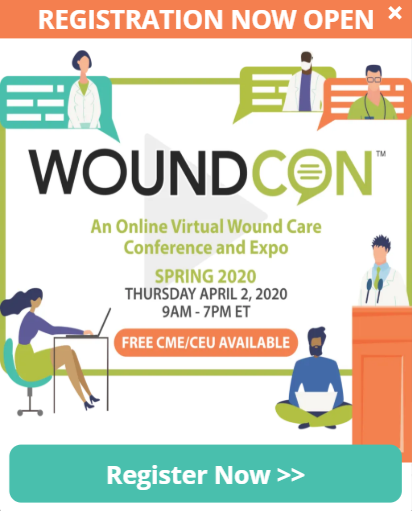Six Wound Care Habits to Give up for the New Year
January 9, 2020
By Emily Greenstein, APRN, CNP, CWON, FACCWS
The New Year is finally here, the beginning of a new decade. And we all know that with the calendar change comes the urge to get rid of any and all bad habits. Time to start over, wipe the slate clean, and transform into something amazing. Except, in reality it never seems to happen that way. We may start out well and then fall off the wagon and back into old habits.
Wound Care Habits to Give up in 2020
Having said that I think that there are a few "bad habits" related to wound care that we can give up. These are small changes that can have a big impact on our patient outcomes. Remember, no change is too small to make a huge difference!
Register for WoundCon today to attend Emily Greenstein's session on exudate management.
1. Not performing sharp debridement. As wound care providers, we know that debridement is essential to promote healing and prevent infection. However, are we all performing debridement frequently enough, and are we doing it adequately? Several sources recommend debridement as a standard of care and state that it should be performed at each visit. Sequential sharp debridement of wounds disrupts biofilm growth and inhibitory factors, and it can promote faster healing.1
2. Using wet-to-dry dressings. With so many advanced dressings on the market, why is it that the most commonly prescribed dressing type is one that has been used since World War I? This type of dressing is non-selective and removes healthy and non-healthy tissue, is painful, can leave behind strands of gauze, can cause wounds to loose moisture, and can serve as a vector for bacteria. An interesting side note: I was recently trialing a fluorescent wound imaging device* while seeing a patient another provider had been treating. The other provider had placed a wet-to-dry dressing on the patient's wound. The image produced by the fluorescent wound imaging device revealed bacteria in a perfect square of the gauze on the patient's leg.
3. Ignoring the basics. We are all familiar with the terms "gold-standard" or "standard of care," but we are not all practicing what we preach. For example, we all know that patients with a venous stasis ulcer should be receiving compression at a level of 30mmHg to 40mmHg and that all diabetic foot ulcers should be offloaded. Yet only about 17% of patients with venous stasis ulcers in the United States are receiving adequate compression, and only about 6% of diabetic foot ulcers are correctly offloaded with total contact casting.2 Other basic things we might forget about or overlook are the simple tests: ankle-brachial indexes to check for blood flow, hemoglobin A1c levels in patients with diabetes, venous insufficiency ultrasound scans, and blood tests for inflammation and nutritional status. And asking the patient or family member questions, back to the basics of a complete history and physical.
4. Forgetting about nutrition. We know nutrition is important, especially this time of year. There are so many ads for eating healthy and new fad diets. But what about when it comes to wound care? Suboptimal nutrition can alter immune function, collagen synthesis, and wound tensile strength, all of which are essential to the wound healing processes.3 Also remember that optimal nutrition is important not just for patients with wounds, but also for patients who are in the pre-operative state. There is a lot of buzz around the idea of surgical optimization to prevent post-operative wounds and complications.
5. Not knowing when to ask for help. I added this one because I recently was asked to do a presentation for a multidisciplinary group on wound care. This made me realize wound care is definitely a team sport, and all the players should be utilized to their full potential. In my practice, I am fortunate to be part of a hospital group and have access to all different specialties. I am not an expert in the structural changes of the foot caused by diabetes or the precise stent that may benefit a patient with poor arterial flow. That is why referring patients early and working together as a team are important. Referring doesn't mean you are a failure. It means you are a great provider who is looking out for your patient's best interest.
6. Not staying up to date on continuing education. I often hear from providers, "I do it this way because it is the way it has always been done." Not staying up to date on evidence-based practice is a habit we all need to do away with this year. Set a goal of attending a wound care conference. There are many options around the country. I have been fortunate enough to attend and present at several different conferences in the past year, Some of my favorites include the fall and spring Symposium of Advanced Wound Care4 meetings, PRESENT Podiatry's Desert Foot,5 and the Wound Ostomy and Continence Nurses Society6 annual conference. You can also stay up-to-date by reading journals, attending online webinars, and reading blogs like this one.
Conclusion
There you have it. A few simple New Year's resolutions you can implement in your everyday practice. They can help you become a better provider, to continue learning and improving, and improve your patient outcomes. That being said, as with any resolutions, start small and remember even the smallest amount of change can have a big impact. Happy New Year and have a great 2020.
References
1. Leaper D. Sharp technique for wound debridement. World Wide Wounds. 2002. http://www.worldwidewounds.com/2002/december/Leaper/Sharp-Debridement.h…. Accessed on January 6, 2020.
2. Fife CE, Carter MJ, Walker D. Why is it so hard to do the right thing in wound care? Wound Repair Regen. 2010;18(2):154-158.
3. Khardori NM, Quain, AM. Nutrition in wound care management: a comprehensive overview. Wounds. 2015:27(12):327-335.
4. Symposium of Advanced Wound Care (SAWC). HMP Global. www.sawcspring.com. Accessed on January 6, 2020.
5. Desert Foot. PRESENT Podiatry. www.desertfoot.org. Accessed on January 6, 2020.
6. Wound Ostomy and Continence Nurses Society (WOCN). WOCNext. www.wocn.org. Accessed on January 6, 2020.
About the Author
Emily Greenstein, APRN, CNP, CWON, FACCWS is a Certified Nurse Practitioner at Sanford Health in Fargo, ND. She received her BSN from Jamestown College and her MSN from Maryville University. She is certified as an Adult-Gerontology Nurse Practitioner through the American Academy of Nurse Practitioners. She has been certified in wound and ostomy care through the WOCNCB for the past 8 years. At Sanford she oversees the outpatient wound care program, serves as chair for the SVAT committee and is involved in many different research projects. She is an active member of the AAWC and currently serves as co-chair for the Research Task Force and Membership Committee. She is also a working member of the AAWC International Consolidated Diabetic Ulcer Guidelines Task Force. She has been involved with other wound organizations and currently serves as the Professional Practice Chair for the North Central Region Wound, Ostomy, and Continence Society. Emily has served as an expert reviewer for the WOCN Society and the Journal for WOCN. Her main career focus is on the advancement of wound care through evidence-based research.
*The MolecuLight® i:X Imaging Device (MolecuLight, Pittsburgh, PA) is approved by Health Canada for sale in Canada, has CE marking for sale in the European Union, and has received clearance by the Food and Drug Administration. .
The views and opinions expressed in this blog are solely those of the author, and do not represent the views of WoundSource, HMP Global, its affiliates, or subsidiary companies.













Follow WoundSource
Tweets by WoundSource